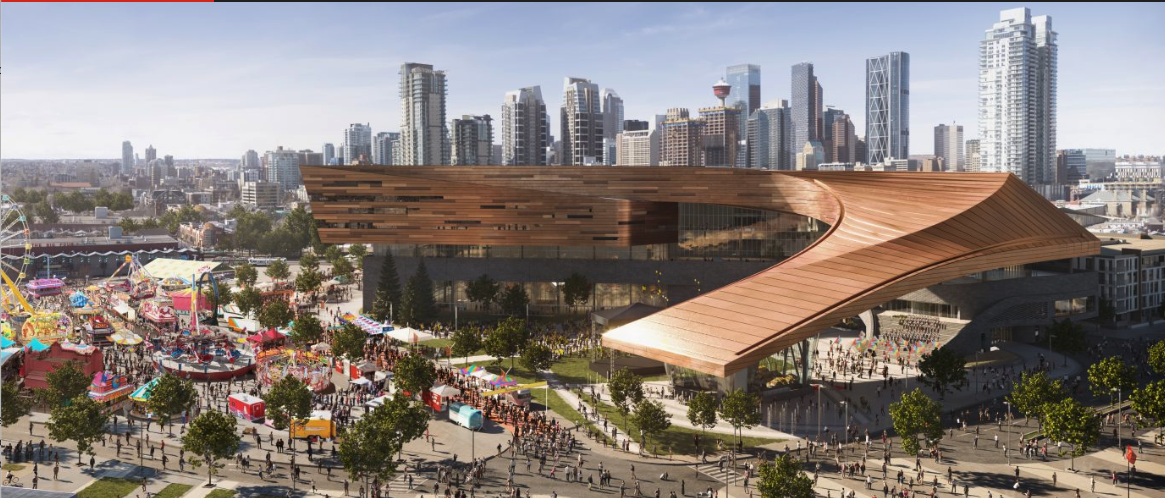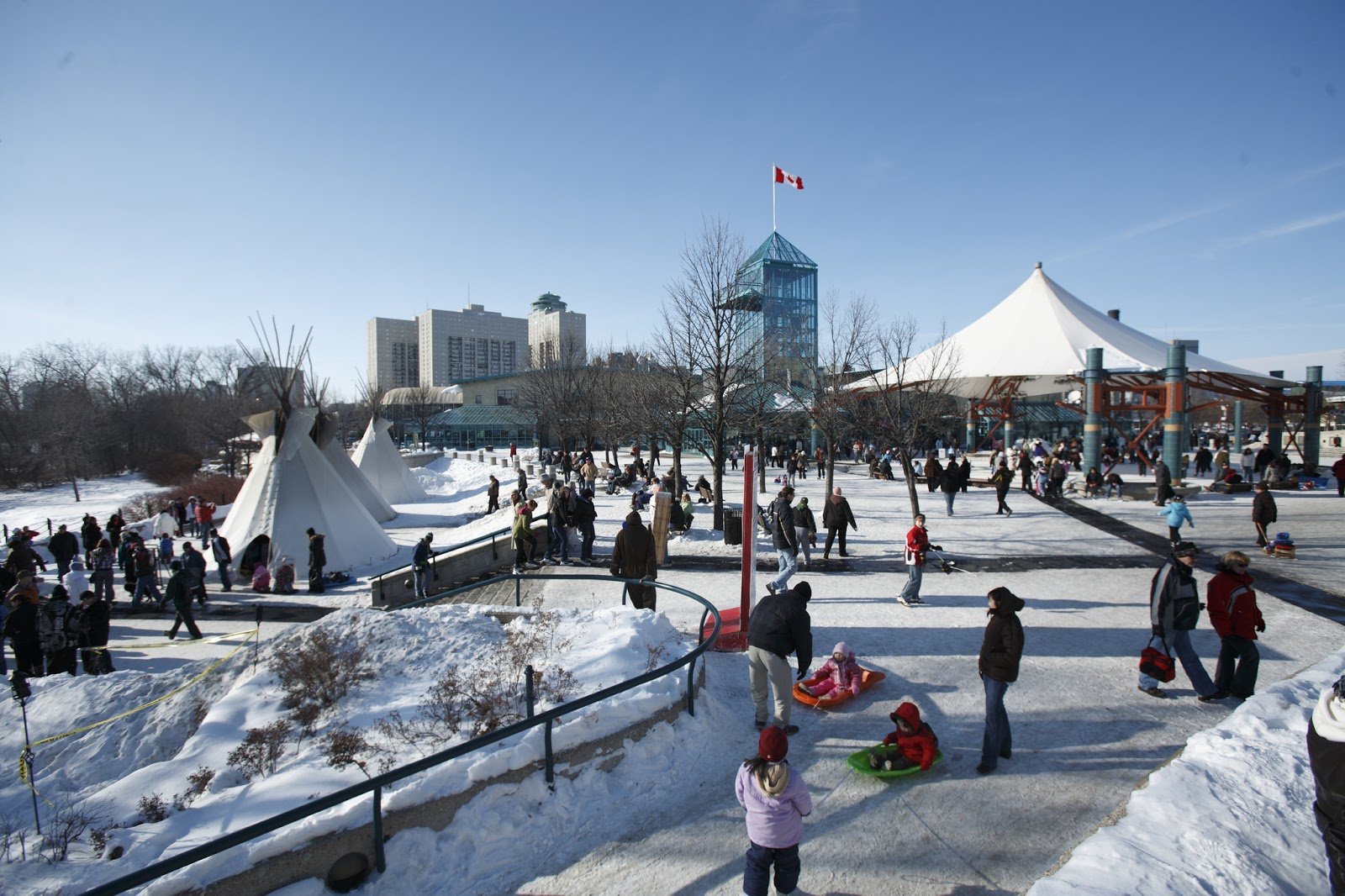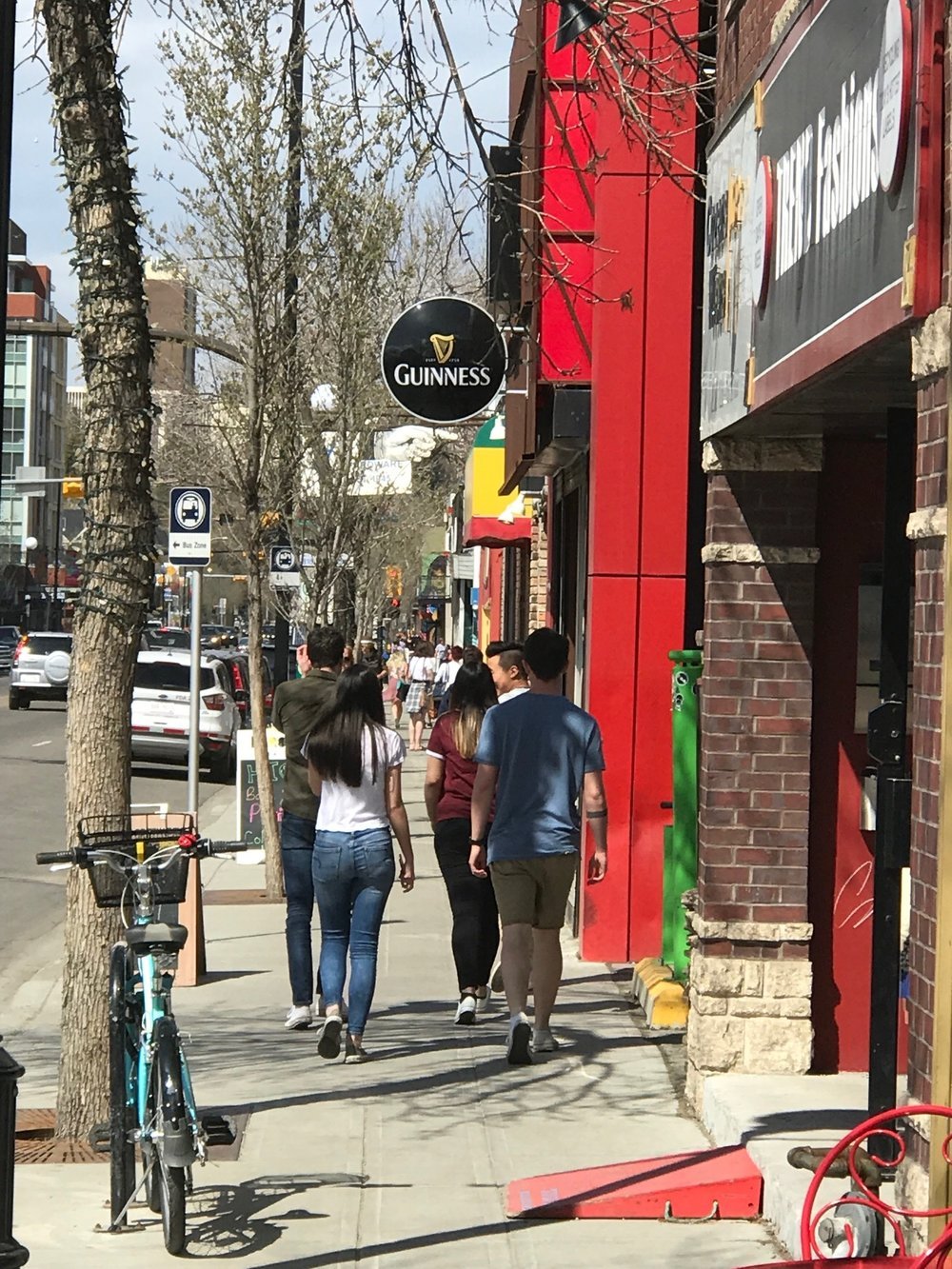City Centre urban renewal is often just urban cannibalism!
Recent visits to Edmonton and Winnipeg have confirmed for me that while many urban renewal projects are touted by developers, planners and politicians as something that will renew the vitality of the city centre, too often they just cannibalize the vitality from nearby streets and plazas.
Calgary’s expanded BMO Event Centre is part of a mega makeover of Stampede Park to enhance it as a year-round cultural and entertainment district with its own Main Street. But what will that mean for Calgary’s downtown, Stephen Avenue (Main Street) and Olympic Plaza Arts district. The plan incudes not only the convention centre expansion but Stampede Trail main street with retail, restaurants, bars, clubs and hotels, but also a new arena and several major residential towers.
Will it be like The Forks in Winnipeg and the Ice District in Edmonton?
Edmonton: ICE District
In Edmonton, there’s great excitement about what the ICE District and the spectacular Rogers Place arena is bringing to their City Centre. But in reality, it is competing with Churchill Square as the “go-to-place” downtown. And it is just another nail in the coffin of Jasper Avenue - Edmonton’s historic downtown main street.
The ICE District’s new office and hotel spaces haven’t attracted many new tenants or increased tourism, but just cannibalized existing office tower tenants and hotel visitors. The Manulife Place office tower is like ghost town.
While one would hope the ICE District might save Edmonton’s downtown retail, in fact the downtown Hudson’s Bay closed in May 2020 and the nearby Edmonton City Centre (indoor shopping mall) is deserted.
Back in 1981, the then new West Edmonton Mall replaced downtown as place to go in the city to shop and be entertained. In many ways, it created a new downtown, based on late 20th century consumer demands and its downtown has struggled ever since.
Edmonton’s downtown Hudson’s Bay department store which was located on Jasper Avenue and then moved to the City Centre shopping mall is now closed. Both Jasper Avenue and the City Centre Mall are struggling to find tenants, while the new Ice District is thriving.
While Edmonton’s downtown is not longer “Deadmonton” as a result of the new Ice District, Jasper Avenue the downtown’s Main Street is struggling and has been for decades.
A plan for a new more modern pedestrian design for Jasper Avenue is in place, but will this be enough to attract new tenants, locals and tourists.
Winnipeg: The Forks / The SHED
In Winnipeg, The Forks has become THE place to go for locals and tourists, not their downtown. Located at the junction of the Red and Assiniboine Rivers, The Forks appeals to the human desire to relax next to water. Over the past 20+ years The Forks has gradually sucked the life out of Winnipeg’s downtown, by creating an attractive “people place” to hang out with its food hall, museums, baseball park, events, and activities for people of all ages and backgrounds. It is the equivalent of Calgary’s East Village revitalization.
And while many tout how a new arena can revitalize Calgary’s Victoria Park, Winnipeg’s Canada Life Centre (arena) built in 2004 right on Portage Avenue in the middle of downtown core, has done nothing to help save Winnipeg’s main street. Today many of the stores along Portage Avenue are empty. To be fair some of that is due to COVID.
Now nearly twenty years later, the City and developers are working to create a SHED (sports, hospitality, Entertainment District) linking the arena with the convention centre with new office, residential and hotel development, which will further erode the street life of Portage Avenue.
Winnipeg’s iconic Hudson’s Bay department store located just a few blocks from the arena closed in November 2020 (plans are currently being developed by the Southern Chief’s Organization to transform the 655,000 square foot building into mix of uses including affordable housing). And their mega downtown indoor shopping centre, Portage Place (which opened in 1987, is pretty much empty. A recent $400 million plan to redevelop Portage Place by add two 20-storey residential towers (30% affordable housing) above, with new retail and office space has fallen through.
Will the new 42-storey, 300 Main residential tower at the corner of Portage and Main bring life back to this iconic Canadian street corner? Is it the beginning of linking Winnipeg’s downtown core with The Forks and revitalization of Main Street? One of its anchor tenants is an Earl’s restaurant, however, it will replace an existing Earl’s just a few blocks away.
The question is - can Winnipeg support three vibrant urban districts - Downtown, Exchange District and The Forks. Or do they just compete for the same retail, restaurant, recreation, office tenants and visitors.
Winnipeg’s Portage Avenue is a brutal place for pedestrians in the winter.
Winnipeg’s downtown transit hub in winter is a very unpleasant place to wait for a bus.
Winnipeg’s downtown Portage Place Mall is like a ghost town, as is their entire skywalk indoor walkway.
Winnipeg’s downtown Canada Life arena is one of the busiest arena’s in North America with a diversity of events including NHL hockey. It has attracted significant development behind it, including an expanded Convention Centre, but it has done nothing to improve the vibrancy of Winnipeg’s Portage Avenue aka Main Street.
The Forks is Winnipeg’s year-round urban gathering place.
In the winter, The Forks is the place to go with its many outdoor activities.
The Forks is a popular place for people to meet up and go skating along the river.
Winnipeg has become famous for its winter warming hut design competition organized by The Forks.
The Forks Market and Johnson Terminal are attractive indoor venues year-round.
Today, The Forks is Winnipeg’s urban playground, where locals and tourists go to enjoy and experience the city’s “sense of place,” not downtown.
Calgary: C+E District
I have long been worried the planned SHED project at Stampede Park - now branded as the C+E District (culture and entertainment) - will cannibalize merchants from Stephen Avenue and 17th Avenue to create a new main street.
Will it cannibalize Calgary’s existing Olympic Plaza Arts & Entertainment District? Will the expanded BMO Centre result in the closing of the Calgary Telus Convention Centre?
Did the relocation of the Central Library to enhance the vitality of East Village resulted in a decline in the vitality of Olympic Plaza? Why was there no plan to repurpose the old library, to heighten the vitality of the plaza?
The construction of new office towers like The Bow, Brookfield Place and Telus Sky just emptied out other downtown office towers like the Nexen/Nova tower and Scotia Tower (now Stephen Avenue Place). There was not a net increase in tenants to the downtown, just a shuffling around of existing tenants.
The construction of the Bow River Promenade in Eau Claire and East Village’s River Walk made downtown’s Stephen Avenue Walk redundant for many looking for a downtown stroll. On a nice Saturday or Sunday afternoon there can be thousands of people strolling along the river, while Stephen Avenue might have a hundred people.
The construction of state-of-the-art fitness facilities in every new downtown office and residential development cannibalized the Eau Claire Y, as residents and workers remain in their buildings rather than going to the Y.
One really must wonder if Calgary can support a vibrant Stephen Avenue Walk, Olympic Plaza Arts & Entertainment District, East Village, Stampede Park, 17th Avenue, 4th Street, Eau Claire/Prince’s Island, Inglewood, and Kensington Village, as well as the new C+E District, in its City Centre?
The assumption is the more main streets the merrier, but, too many means they all struggle.
Calgary’s Stephen Avenue Walk still thrives in the summer but struggles in the winter. It is still home to three department stores - The Bay, Simons and Holt Renfew. Note the Bay’s upper floor is now leased as office space and the basement is leased to a major restaurant.
Stephen Avenue has a vibrant patio scene in the summer.
Olympic Plaza anchors the east end of Stephen Avenue. It is home to numerous events, festivals and skating in the winter.
The Core indoor shopping centre on Stephen Avenue continues links the three department stores and is easily accessible by downtown workers via Calgary’s extensive +15 indoor walkway.
Arts Commons at the east end of Stephen Avenue, is one of North America’s largest performing arts centres. It includes a major concert hall, two major theatre spaces and two smaller multi-user performance spaces.
Stephen Avenue has several major hotels on or nearby - Hyatt Regency (in photo), Marriott, Fairmont Palliser and Le Germain Hotel.
Stephen Avenue is surrounded by major office towers, giving it access to 150,000 workers during the week.
Just a block away from Stephen Avenue is Calgary’s 7th Avenue Transit corridor. Before COVID Calgary’s LRT had one of the highest riderships in North America.
Despite Stephen Avenue Walk having all of ingredients of a vibrant Main Street it struggles to compete with nearby main streets in Kensington Village, 17th Avenue, 4th Street and Inglewood for pedestrian vitality.
Last Word
Will the addition of another Main Street, public plaza, entertainment hub at Stampede Park just cannibalize the pedestrian vitality of the City Centre’s other main streets.
While it is important for cities to constantly upgrade their office, hotel, retail, residential, cultural and public spaces, it is important to ensure that new construction is done in a way that is synergistic with and not antagonistic to existing spaces and places.
Although the intentions of developers, urban planners, cultural groups, and influencers is often focused on being “additive;” the sky isn't always the limit. Overbuilding, be it office, entertainment or hospitality is an issue that often isn't realized until it is hugely problematic.
Note and edited version of this blog was published in the Calgary Herald’s New Homes + Condos section, May 28, 2022.
If you like this blog, you might like these links:
Calgary vs Edmonton: Urban Thinking, Planning & Living

























